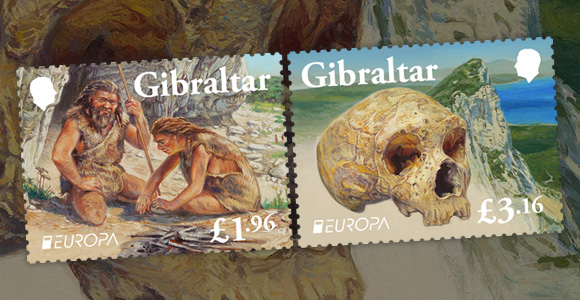Home -> Stamps -> 2025 -> Europa 2025
We also recommend:

Europa 2025 (view technical specs)
The Gibraltar Neanderthal skulls are among the most significant fossil discoveries related to Neanderthals. The first skull, known as the Forbes’ Quarry Skull or Gibraltar 1, was discovered in 1848 at Forbes’ Quarry, on the northern face of the Rock of Gibraltar. This find predated the famous discovery of Neanderthals in Germany’s Neander Valley (1856), but its importance wasn’t fully recognised at the time. The skull is that of an adult female and exhibits classic Neanderthal features such as a large brow ridge, a long, low skull, and a robust build. It remains one of the best-preserved Neanderthal skulls ever found.
A second skull, Gibraltar 2, was found in 1926 close to Forbes’ Quarry, at Devil’s Tower Cave and belonged to a Neanderthal child. This discovery provided valuable insights into the growth and development of Neanderthals. Studies of the Gibraltar Neanderthals suggest they were among the last surviving populations of their species, with evidence indicating that Neanderthals lived in the region until around 32,000 years ago, long after they had disappeared from much of Europe.
Gibraltar’s caves, particularly Gorham’s Cave, on the Rock’s eastern side, have provided further evidence of Neanderthal life, including hearths, tools, and even possible engravings that suggest symbolic behavior. The region’s mild climate and rich marine resources may have contributed to the Neanderthals’ prolonged survival. Today, the Gibraltar skulls are housed in the Natural History Museum in London, and Gorham’s Cave is a UNESCO World Heritage Site, recognised for its importance in understanding Neanderthal history.
Recent research on the Gibraltar Neanderthals has shed light on their diet, behavior, and cognitive abilities. Isotopic analysis of remains from Gorham’s Cave suggests that these Neanderthals had a diverse diet, including marine resources such as shellfish, fish, and seals, challenging earlier notions that Neanderthals were primarily big-game hunters. Additionally, discoveries of charred plant remains indicate they also consumed roasted vegetables. Perhaps most intriguingly, an engraving found in Gorham’s Cave, a cross-hatched pattern etched into the rock, has been interpreted as possible evidence of symbolic or artistic behavior, suggesting that Neanderthals were capable of abstract thought. These findings contribute to the growing understanding that Neanderthals were not the brutish, primitive beings they were once thought to be, but rather intelligent and adaptable hominins capable of complex survival strategies.
Technical Specs
| Design: | Stephen Perera |
| Illustration / Photography: | Jonathan Pointer |
| Printer: | Cartor Security Printers |
| Process: | Offset Lithography |
| Colours: | 4 Colours |
| Stamp size: | Stamps: 40 x 30mm, Miniature Sheet: 105 x 71mm |
| Issue date: | 2025-05-08 |
| Stamp Values: | £1.96, £3.16 |













